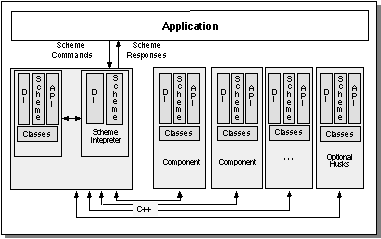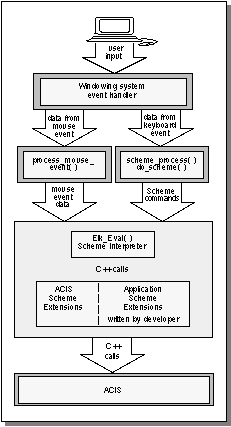Scheme Interface
Scheme is an interpretive, public domain language, derived from LISP, that provides rapid and easy prototyping capabilities. Unlike many interpretive languages, it runs very efficiently. Most developers who use Scheme find little or no need to translate their Scheme code into C++ or another compiled language.
Because Scheme is interpretive, there is no compile or link phase for Scheme procedures and it can be used immediately for training. Scheme is particularly suited to control tasks such as user interface command processing. It is extensible and portable to all ACIS supported platforms.
The Scheme interface is a collection of functions that allows a Scheme-based application to access ACIS functionality. Applications interface to ACIS via the ACIS Scheme Interpreter (which is based on the Elk version of the Scheme language), which processes Scheme commands. Scheme commands may be native Scheme commands, ACIS Scheme extensions, or application-specific Scheme extensions created by the developer.
The following figure illustrates how a Scheme application is built on top of ACIS, interfacing to the Scheme support component via the Scheme Interpreter, which then interfaces to the rest of ACIS using C++ calls.

Figure. Scheme Application Interface to ACIS
Developers can create their own Scheme extensions and data types to extend Scheme. The Scheme data types and extensions are described in reference templates in online help.
Scheme ACIS Interface Driver Extension (Scheme AIDE) is a Scheme based ACIS demonstration application. Refer to Using Scheme AIDE, and the Scheme Support Component for information about using this application.
The following figure illustrates the flow of control between the end user and ACIS when using the Scheme interface.

Figure. Scheme Interface Flow of Control
[Top]
© 1989-2007 Spatial Corp., a Dassault Systèmes company. All rights reserved.